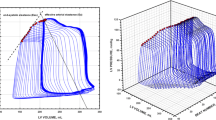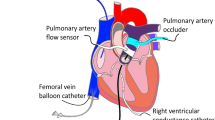Summary
In contrast to the left ventricle, the maximal rate of intraventricular pressure rise in the right ventricle does not occur within the isovolumic phase of the contraction. Occlusion of the pulmonary artery by inflation of a balloon during the diastole causes an isovolumic systole of the following heart beat. The canine heart-lung preparation was used to test whether dP/dtmax measured isovolumically and the peak ventricular pressure Pmax as well as the parameters derived are useful indices for the contractile state of the right ventricle.
Changes only of the aortic pressure influence neither dP/dtmax, Pmax and the time values from the onset of contraction to dP/dtmax (t-dP/dtmax), nor the time to Pmax (t-Pmax). A rise in heart frequency leads to an increase in dP/dtmax and Pmax at lowered enddiastolic pressure. It does not influence the time interval t-dP/dtmax and t-Pmax. With augmented diastolic filling, dP/dtmax as well as Pmax increase, and t-dP/dtmax and t-Pmax are extended.
The present study suggests that dP/dtmax and Pmax measured isovolumically provide accurate and practical measurements of right ventricular contractility, provided that changes in enddiastolic pressure and heart frequency are taken into account. The time parameters are found to be not useful.
Zusammenfassung
Im Gegensatz zum linken Ventrikel liegt die größte Druckanstiegsgeschwindigkeit im rechten Ventrikel gewöhnlich nicht innerhalb der isovolumetrischen Kontraktionsphase. Durch Verschluß der Pulmonalarterie (Aufblasen eines Ballons) innerhalb der Diastole kann ein isovolumetrischer Verlauf der folgenden Systole erzwungen werden.
Am Herz-Lungen-Präparat des Hundes wird geprüft, inwieweit das isovolumetrisch gemessene dP/dtmax und der maximale Ventrikeldruck Pmax sowie die Zeit vom Beginn der Kontraktion bis dP/dtmax (t-dP/dtmax) bzw. bis Pmax (t-Pmax) als Maß für die Kontraktilität des rechten Ventrikels brauchbar sind.
Alleinige Änderung des Aortendrucks bleibt ohne Einfluß auf dP/dtmax und Pmax sowie t-dP/dtmax bzw. t-Pmax. Die Erhöhung der Herzfrequenz führt zu einer Vergrößerung von dP/dtmax und Pmax bei sinkendem enddiastolischem Druck (EDP) und bleibt ohne Einfluß auf t-dP/dtmax und t-Pmax.
Mit Erhöhung der enddiastolischen Füllung nehmen sowohl dP/dtmax als auch Pmax deutlich zu, und t-dP/dtmax und t-Pmax werden im Mittel länger. Verbesserung (Strophanthin) oder Verschlechterung (Hypoxie) der Kontraktilität werden bei der isometrischen Kontraktion des rechten Ventrikels von dP/dtmax und Pmax eindeutig wiedergegeben. Von den hier geprüften Parametern lassen nur dP/dtmax und Pmax unter Berücksichtigung des enddiastolischen Drucks und der Herzfrequenz bei isovolumetrischer Kontraktion eindeutige Angaben über die Kontraktilität des rechten Ventrikels zu, während die Zeitparameter unbrauchbar sind.
Similar content being viewed by others
References
Abel, R. M., R. L. Reis, Circulat. Res27, 961–971 (1970).
Adam, H., Pflügers Arch.111, 607–619 (1906).
Arnold, G., C. Morgenstern, W. Lochner, Pflügers Arch.321, 34–55 (1970).
Covell, J. W., J. Ross Jr., E. H. Sonnenblick, E. Braunwald, Circulat. Res.19, 364–372 (1966).
Frank, O. Z. Biol.,32, 370–447 (1895).
Furnival, C. M., R. J. Linden, H. M. Snow, J. Physiol.211, 359–387 (1970).
Geha, A. S., J. C. Swan, Amer. J. Physiol.217, 1565–1569 (1969).
Köhler, E., K. Greef, Z. Kreislaufforschg.60, 918–927 (1971).
Knowlton, F. P., E. H. Starling, J. Physiol.44, 206–219 (1912).
Krayer, O., E. Schütz Z. Biol.92, 453–461 (1932).
Limbourg, P., W. Wende, H. Heinrich, U. Peiper Pflügers Arch.322, 250–263 (1971).
Mason, D. T., E. H. Sonnenblick, J. Ross Jr.,J. W. Covell, E. Braunwald, Circulation32, Suppl. 2, 145 (1965).
D. T. Mason, Amer. J. Cardiol.23, 516–527 (1969).
Mitchell, J. H., A. G. Wallace, N. S. Skinner Jr., Amer. J. Physiol.205, 41–48 (1963).
Morgenstern, G., G. Arnold, U. Höltjes, W. Lochner, Pflügers Arch.315, 173–186 (1970).
Niehues, B., V. Schwanitz, K. Hagemann, S. Manoli, S. Oswald, G. Arnold, W. Lochner, Z. Kardiol.62, 1029–1040 (1972).
Schmidt, H. D., H. Hoppe, W. Schneider, Verh. Dtsch. Ges. Kreislaufforschg.39, 151–156 (1973).
Siegel, J. H., E. H. Sonnenblick, Circulat. Res.12, 597–610 (1963).
Siegel, J. H., E. H. Sonnenblick, R. D. Judge, W. S. Wilson, Cardiologia45, 189–220 (1964).
Sonnenblick E. H., Amer. J. Physiol.202, 931–939 (1962).
Veragut, U.-P., H. P. Krayenbühl, Cardiologia47, 96–112, (1965).
Wallace, A. G., N. S. Skinner, J. H. Mitchell, Amer. J. Physiol.205, 30–36 (1963).
Wildenthal, K., D. S. Mierzwiak, J. H. Mitchell, Amer. J. Physiol.216, 185–190 (1969).
Author information
Authors and Affiliations
Additional information
With 5 figures
Rights and permissions
About this article
Cite this article
Schmidt, H.D., Hoppe, H. Maximal rate of pressure rise and time parameters in the right ventricle under isovolumic conditions. Basic Res Cardiol 71, 521–529 (1976). https://doi.org/10.1007/BF01909766
Received:
Issue Date:
DOI: https://doi.org/10.1007/BF01909766




